Mixed, Augmented and Virtual, Reality Applied to the Teaching of Mathematics for Architects
Abstract
1. Mixed Reality Applied to Training
2. Research Carried Out
2.1. Research Objectives
- (a)
- Ascertaining the degree of technological acceptance that the use of Mixed Reality (MR), Augmented Reality (AR) and Virtual Reality (VR) arouses amongst university architecture students in mathematics teaching.
- (b)
- Checking whether significant differences exist according to students’ gender in their perception of technical mastery regarding audiovisual resources, computer resources and the Internet.
- (c)
- Analyzing the extent to which students’ gender influenced their perceptions about MR as a training tool that could be used to teach architecture mathematics.
- (d)
- Verifying whether the degree of technological acceptance depends on the technical mastery expressed regarding audiovisual resources, computer resources and the Internet.
2.2. Information Collection Tools
2.3. The Sample
2.4. The Material Produced
3. Results Achieved
4. Discussions
5. Conclusions
Author Contributions
Funding
Institutional Review Board Statement
Informed Consent Statement
Data Availability Statement
Conflicts of Interest
References
- Barroso-Osuna, J.; Gutiérrez-Castillo, J.J.; Llorente-Cejudo, M.D.C.; Valencia Ortiz, R. Difficulties in the Incorporation of Augmented Reality in University Education: Visions from the Experts. J. New Approaches Educ. Res. 2019, 8, 126–141. [Google Scholar] [CrossRef]
- Cabero, J.; Puentes, A. La realidad Aumentada: Tecnología emergente para la sociedad del aprendizaje. Aula. Rev. De Humanid. Y Cienc. Soc. 2020, 66, 137–158. [Google Scholar]
- Johnson, L.; Adams, S. NMC Horizon Report: 2016 Higher Education Edition; The New Media Consortium: Austin, TX, USA, 2016. [Google Scholar]
- Tecnológico de Monterrey. EduTrends. Realidad Aumentada y Virtual; Tecnológico de Monterrey: Monterrey, Mexico, 2017. [Google Scholar]
- Flores, J.; Camarena, P.; Avalos, E. La Realidad Virtual una Tecnología Innovadora Aplicable al Proceso de Enseñanza de los Estudiantes de Ingeniería. Apertura. Rev. De Innovación Educ. 2014, 6. Available online: http://www.udgvirtual.udg.mx/apertura/index.php/apertura/article/view/547/369 (accessed on 18 June 2021).
- Hsu, Y.; Lin, Y.; Yang, B. Impact of augmented reality lessons on students’ STEM interest. Res. Pract. Technol. Enhanc. Learn. 2017, 12, 1–14. [Google Scholar] [CrossRef] [PubMed]
- Cabero-Almenara, J.; Barroso-Osuna, J.; Llorente-Cejudo, C.; Fernández, M.M. Educational Uses of Augmented Reality (AR): Experiences in Educational Science. Sustainability 2019, 11, 4990. [Google Scholar] [CrossRef]
- Borrel, A.; Fourches, D. RealityConvert: A tool for preparing 3D models of biochemical structures for augmented and virtual reality. Bioinformatics 2017, 33, 3816–3818. [Google Scholar] [CrossRef]
- Fracchia, C.; Alonso, A.; Martins, A. Realidad Aumentada aplicada a la enseñanza de Ciencias Naturales. Rev. Iberoam. De Educ. En Tecnol. Y Tecnol. En Educ. 2015, 16, 7–15. [Google Scholar]
- Nasharuddin, N.A.; Khalid, N.A.; Hussin, M. InCell VR: A Virtual Reality-based Application on Human Cell Division for Mobile Learning. Int. J. Interact. Mob. Technol. 2021, 15, 55–71. Available online: https://www.online-journals.org/index.php/i-jim/article/view/18049 (accessed on 18 June 2021). [CrossRef]
- Carbonell, C.; Bermejo, L. Landscape interpretation with augmented reality and maps to improve spatial orientation skill. J. Geogr. High. Educ. 2019, 41, 119–133. [Google Scholar] [CrossRef]
- Huang, T.K.; Yang, C.H.; Hsieh, Y.H.; Wang, J.C.; Hung, C.C. Augmented reality (AR) and virtual reality (VR) applied in dentistry. Kaohsiung J. Med Sci. 2018, 34, 243–248. [Google Scholar] [CrossRef]
- Barroso, J.; Cabero, J. Evaluación de objetos de aprendizaje en Realidad Aumentada: Estudio piloto en el Grado de Medicina. Enseñanza Teach. 2016, 34, 149–167. [Google Scholar] [CrossRef][Green Version]
- Cabero-Almenara, J.; Roig-Vila, R. The Motivation of Technological Scenarios in Augmented Reality (AR): Results of Different Experiments. Appl. Sci. 2019, 9, 2907. [Google Scholar] [CrossRef]
- López Belmonte, J.; Pozo Sánchez, S.; López Belmonte, G. La eficacia de la Realidad Aumentada en las aulas de Infantil: Un estudio del aprendizaje de SVB y RCP en discentes de 5 años. Píxel-Bit. Rev. De Medios Y Educ. 2019, 55, 157–178. [Google Scholar] [CrossRef]
- Soltani, P.; Morice, A.H.P. Augmented reality tools for sports education and training. Comput. Educ. 2020, 155, 103923. [Google Scholar] [CrossRef]
- George, C.E. Percepción de estudiantes de bachillerato sobre el uso de Metaverse en experiencias de aprendizaje de realidad aumentada en matemáticas. Píxel-Bit. Rev. De Medios Y Educ. 2020, 58, 143–159. [Google Scholar] [CrossRef]
- Del Río, L.; Sanz, C.; Búcari, N. Incidence of a hypermedia educational material on the Teaching and Learning of Mathematics. J. New Approaches Educ. Res. 2019, 8, 50–57. [Google Scholar] [CrossRef]
- Poot, A.; Martin-Gonzalez, A.; Menendez-Dominguez, V.; Espinosa-Romero, A. Aprendizaje de Vectores Euclidianos utilizando un Sistema de Realidad Aumentada. Res. Comput. Sci. 2015, 89, 9–16. [Google Scholar] [CrossRef]
- Buitrago-Pulido, R.D. Incidencia de la realidad aumentada sobre el estilo cognitivo: Caso para el estudio de las matemáticas. Educ. Y Educ. 2015, 18, 27–41. [Google Scholar] [CrossRef]
- Marinakis, A.; Mania, K.; Antoniadis, A. Augmented reality for cad-cam training featuring 3d interactive geometric transformations. Comput. -Aided Des. Appl. 2021, 18, 561–570. [Google Scholar] [CrossRef]
- Roca-González, C.; Martin-Gutiérrez, J.; García-Domínguez, M.; Mato, M.C. Virtual Technologies to Develop Visual-Spatial Ability in Engineering Students. EURASIA J. Math. Sci. Technol. Educ. 2017, 13, 441–468. [Google Scholar] [CrossRef]
- Del Cerro Velázquez, F.; Morales Méndez, G. Application in Augmented Reality for Learning Mathematical Functions: A Study for the Development of Spatial Intelligence in Secondary Education Students. Mathematics 2021, 9, 369. [Google Scholar] [CrossRef]
- Hwang, W.; Hu, S. Analysis of peer learning behaviors using multiple representations in virtual reality and their impacts on geometry problem solving. Comput. Educ. 2013, 62, 308–319. [Google Scholar] [CrossRef]
- García-Tudela, P.; Prendes-Espinosa, M.; Solano-Fernández, I. Smart Learning Environments and Ergonomics: An Approach to the State of the Question. J. New Approaches Educ. Res. 2020, 9, 245–258. [Google Scholar] [CrossRef]
- Sánchez-López, I.; Pérez-Rodríguez, A.; Fandos-Igado, M. Com-educational Platforms: Creativity and Community for Learning. J. New Approaches Educ. Res. 2019, 8, 214–226. [Google Scholar] [CrossRef]
- Brown, J.; Ortiz-Padilla, M.; Soto-Varela, R. Does Mathematical Anxiety Differ Cross-Culturally? J. New Approaches Educ. Res. 2020, 9, 126–136. [Google Scholar] [CrossRef]
- Davis, F.D. Perceived usefulness, perceived ease of use, and user acceptance of information technology. MIS Q. 1989, 13, 319–340. [Google Scholar] [CrossRef]
- Cabero, J.; Pérez, J.L. Validación del modelo TAM de adopción de la Realidad Aumentada mediante ecuaciones estructurales. Estud. Sobre Educ. 2018, 34, 129–153. [Google Scholar] [CrossRef]
- Teo, T.; Noyes, J. An assessment of the influence of perceived enjoyment and attitude on the intention to use technology among pre-service teachers: A structural equation modeling approach. Comput. Educ. 2011, 57, 1645–1653. [Google Scholar] [CrossRef]
- Hsiao, C.H.; Yang, C. The intellectual development of the technology acceptance model: A co-citation analysis. Int. J. Inf. Manag. 2011, 31, 128–136. [Google Scholar] [CrossRef]
- Gallego, O.; Cabero, J.; Sampedro, B. Valoraciones de la “Aceptación de la Tecnología de Formación Virtual” por profesores universitarios asistentes a un curso de formación virtual. Edutec. Rev. Electrónica De Tecnol. Educ. 2016, 56, a335. [Google Scholar] [CrossRef][Green Version]
- Fernández, B. La utilización de objetos de aprendizaje de realidad aumentada en la enseñanza universitaria de educación primaria. Int. J. Educ. Res. Innov. 2017, 9, 90–104. [Google Scholar]
- Yáñez-Luna, J.C.; Arias-Oliva, M. M-learning: Aceptación tecnológica de dispositivos móviles en la formación online. Tecnología, Cienc. Y Educ. 2018, 10, 13–34. [Google Scholar] [CrossRef]
- Papakostas, C.; Troussas, C.; Krouska, A.; Sgouropoulou, C. Measuring User Experience, Usability and Interactivity of a Personalized Mobile Augmented Reality Training System. Sensors 2021, 21, 3888. [Google Scholar] [CrossRef] [PubMed]
- Cabero, J.; Marín, V. Blended Learning y Realidad Aumentada: Experiencias de diseño docente. RIED. Rev. Iberoam. De Educ. A Distancia 2018, 21, 33–56. [Google Scholar] [CrossRef]
- Álvarez-Marín, A.; Velázquez-Iturbide, J.Á.; Castillo-Vergara, M. Technology Acceptance of an Interactive Augmented Reality App on Resistive Circuits for Engineering Students. Electronics 2021, 10, 1286. [Google Scholar] [CrossRef]
- Cabero-Almenara, J.; Arancibia, M.L.; Del Prete, A. Technical and Didactic Knowledge of the Moodle LMS in Higher Education. Beyond Functional Use. J. New Approaches Educ. Res. 2019, 8, 25–33. [Google Scholar] [CrossRef]
- Garay, U.; Tejada, E.; Castaño, C. Percepciones del alumnado hacia el aprendizaje mediante objetos educativos enriquecidos con realidad aumentada. Edmetic. Rev. De Educ. Mediática Y TIC 2017, 6, 145–164. [Google Scholar] [CrossRef]
- Garay, U.; Tejada, E.; Maiz, I. Valoración de objetos educativos enriquecidos con realidad aumentada: Una experiencia con alumnado de máster universitario. Pixel-Bit. Rev. De Medios Y Educ. 2017, 50, 19–31. [Google Scholar] [CrossRef]
- O’Dwyer, L.; Bernauer, J. Quantitative Research for the Qualitative Researcher; Sage: Riverside County, CA, USA, 2014. [Google Scholar]
- Baena-Morales, S.; Martinez-Roig, R.; Hernádez-Amorós, M.J. Sustainability and Educational Technology—A Description of the Teaching Self-Concept. Sustainability 2020, 12, 10309. [Google Scholar] [CrossRef]
- Kim, K.; Hwang, J.; Zo, H. Understanding users’ continuance intention toward smartphone augmented reality applications. Inf. Dev. 2016, 32, 161–174. [Google Scholar] [CrossRef]
- Coma-Tatay, I.; Casas-Yrurzum, S.; Casanova-Salas, P.; Fernández-Marín, M. FI-AR learning: A web-based platform for augmented reality educational content. Multimed. Tools Appl. 2019, 78, 6093–6118. [Google Scholar] [CrossRef]
- Kerr, J.; Lawson, G. Augmented Reality in Design Education: Landscape Architecture Studies as AR Experience International. J. Art Des. Educ. 2020, 39, 6–21. [Google Scholar] [CrossRef]
- Fernandes, J.; Teles, A.; Teixeira, S. An Augmented Reality-Based Mobile Application Facilitates the Learning about the Spinal Cord. Educ. Sci. 2020, 10, 376. [Google Scholar] [CrossRef]
- Allcoat, D.; Hatchard, T.; Azmat, F.; Stansfield, K.; Watson, D.; von Mühlenen, A. Education in the Digital Age: Learning Experience in Virtual and Mixed Realities. J. Educ. Comput. Res. 2021, 59, 795–816. [Google Scholar] [CrossRef]
- Rojo, A.; Raya, L.; Sanchez, A. A novel mixed reality solution based on learning environment for sutures in minor surgery. Appl. Sci. 2021, 11, 2335. [Google Scholar] [CrossRef]
- Park, K.-B.; Choi, S.H.; Lee, J.Y.; Ghasemi, Y.; Mohammed, M.; Jeong, H. Hands-free human-robot interaction using multimodal gestures and deep learning in wearable mixed reality. IEEE Access 2021, 9, 55448–55464. [Google Scholar] [CrossRef]
- Smith, E.; McRae, K.; Semple, G.; Welsh, H.; Evans, D.; Blackwell, P. Enhancing Vocational Training in the Post-COVID Era through Mobile Mixed Reality. Sustainability 2021, 13, 6144. [Google Scholar] [CrossRef]
- Cabero, J.; Vázquez-Cano, E.; López-Meneses, E. Uso de la Realidad Aumentada como Recurso Didáctico en la Enseñanza Universitaria. Form. Univ. 2018, 11, 25–34. [Google Scholar] [CrossRef]
- Roig-Vila, R.; López Padrón, A.; Urrea-Solano, M. Perfil del uso académico del smartphone entre estudiantes noveles universitarios españoles e iberoamericanos. Am. J. Distance Educ. 2021, 35. [Google Scholar] [CrossRef]
- Pal, D.; Patra, S. University Students’ Perception of Video-Based Learning in Times of COVID-19: A TAM/TTF Perspective. Int. J. Hum. Comput. Interact. 2020, 37, 903–921. [Google Scholar] [CrossRef]
- Jang, J.; Ko, Y.; Shin, W.S.; Han, I. Augmented Reality and Virtual Reality for Learning: An Examination Using an Extended Technology Acceptance Model. IEEE Access 2021, 9, 6798–6809. [Google Scholar] [CrossRef]
- Giganti, P.; Falcone, P.M. Socio-technical transitions and innovation niches: The case of the virtual and augmented reality in Europ. AIMS Energy 2021, 9, 755–774. [Google Scholar] [CrossRef]
- Wojciechowski, R.; Cellary, W. Evaluation of learners’ attitude toward learning in ARIES augmented reality environments. Comput. Educ. 2013, 68, 570–585. [Google Scholar] [CrossRef]
- Marín-Díaz, V.; López-Perez, M.; Fernández-Robles, B. RAFODIUM: A social nets about augmented reality. Pixel-Bit. Revista Medios Educ. 2020, 59, 225–240. [Google Scholar] [CrossRef]
- Lohbeck, A.; Hagenauer, G.; Frenzel, A.C. Teachers’ self-concepts and emotions: Conceptualization and relations. Teach. Teach. Educ. 2018, 70, 111–120. [Google Scholar] [CrossRef]
- Marín, V. The augmented reality in the educational sphere of student of degree in chilhood education. Case study. Píxel-Bit. Rev. De Medios Y Educ. 2017, 51, 7–19. [Google Scholar] [CrossRef]
- Vázquez-Cano, E.; Meneses, E.L.; García-Garzón, E. Differences in basic digital competences between male and female university students of Social Sciences in Spain. Int. J. Educ. Technol. High. Educ. 2017, 14, 27. [Google Scholar] [CrossRef]
- Ríos, J.M.; Gómez, E.; Priscilla, M. Valoración de competencias TIC del profesorado universitario: Un caso en Chile. Pixel-Bit. Rev. De Medios Y Educ. 2018, 52, 55–65. [Google Scholar] [CrossRef]
- Munoz-Montoya, F.; Fidalgo, C.; Juan, M.-C.; Mendez-Lopez, M. Memory for Object Location in Augmented Reality: The Role of Gender and the Relationship among Spatial and Anxiety Outcomes. Front. Hum. Neurosci. 2019. [Google Scholar] [CrossRef] [PubMed]
- Neffatia, O.S.; Setiawan, R.; Jayanthic, P.; Vanithamani, S.; Sharma, D.K.; Regin, R.; Mani, D.; Sengan, S. An educational tool for enhanced mobile e-Learning for technical higher education using mobile devices for augmented reality. Microprocess. Microsyst. 2021, 83, 104030. [Google Scholar] [CrossRef]
- González-Calatayud, V.; Prendes-Espinosa, P.; Roig-Vila, R. Artificial Intelligence for Student Assessment: A Systematic Review. Appl. Sci. 2021, 11, 5467. [Google Scholar] [CrossRef]
- Diao, P.-H.; Shih, N.-J. Trends and Research Issues of Augmented Reality Studies in Architectural and Civil Engineering Education—A Review of Academic Journal Publications. Appl. Sci. 2019, 9, 1840. [Google Scholar] [CrossRef]
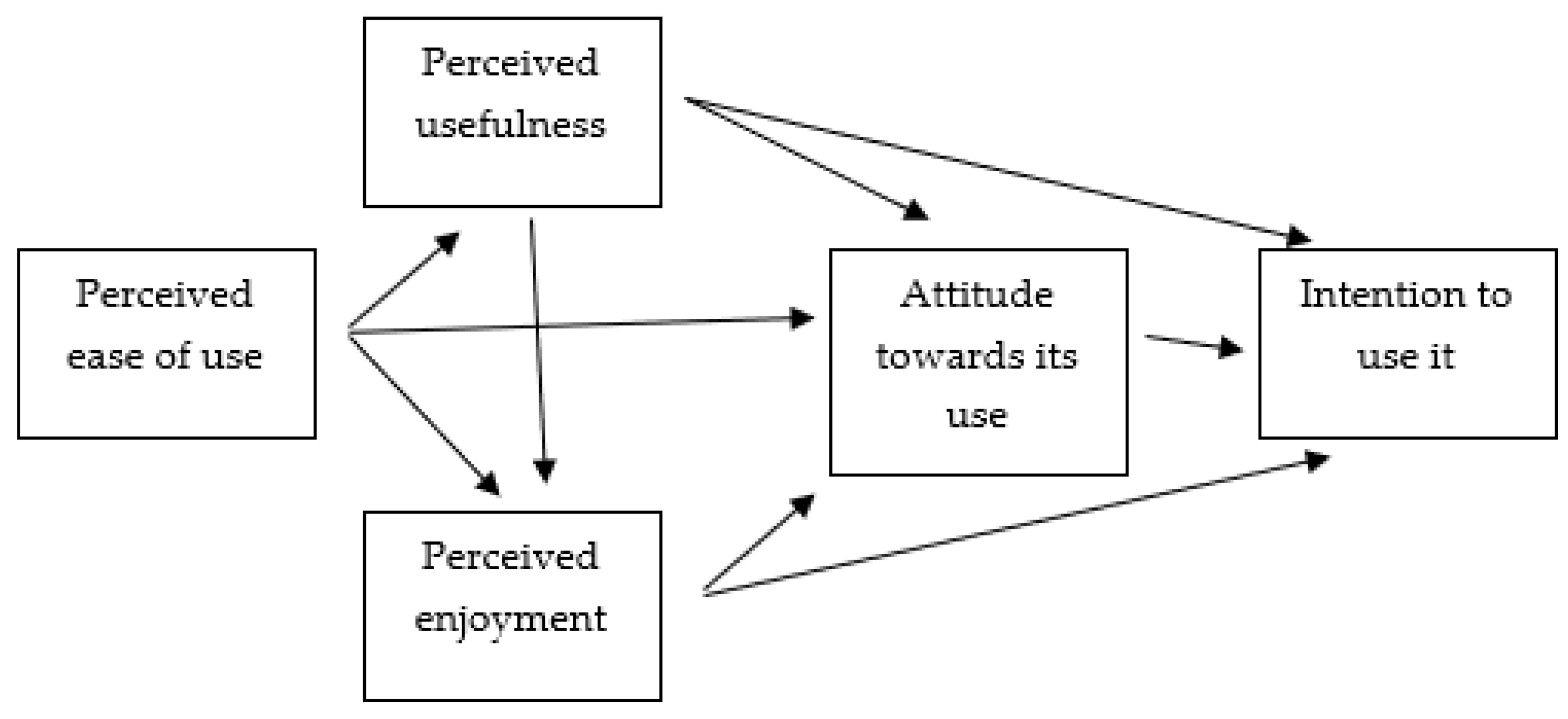
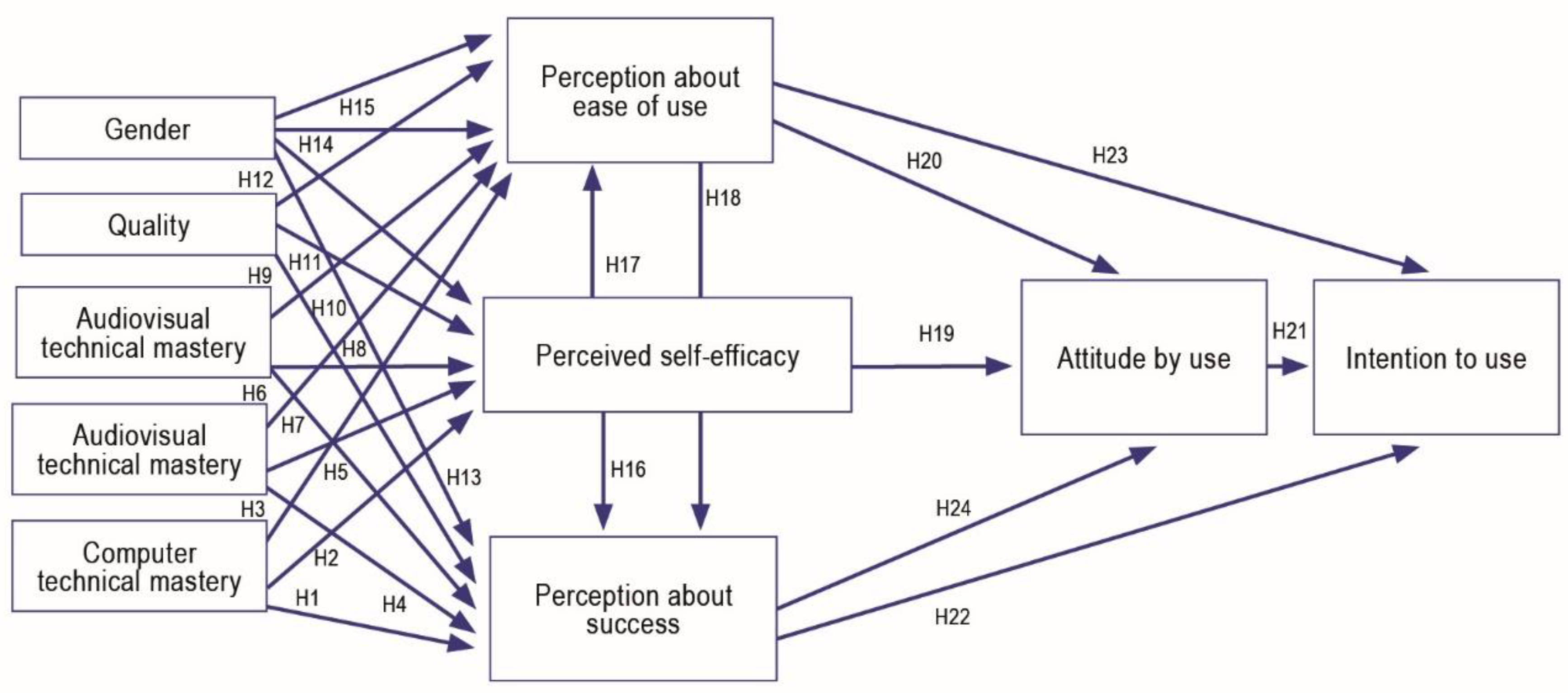
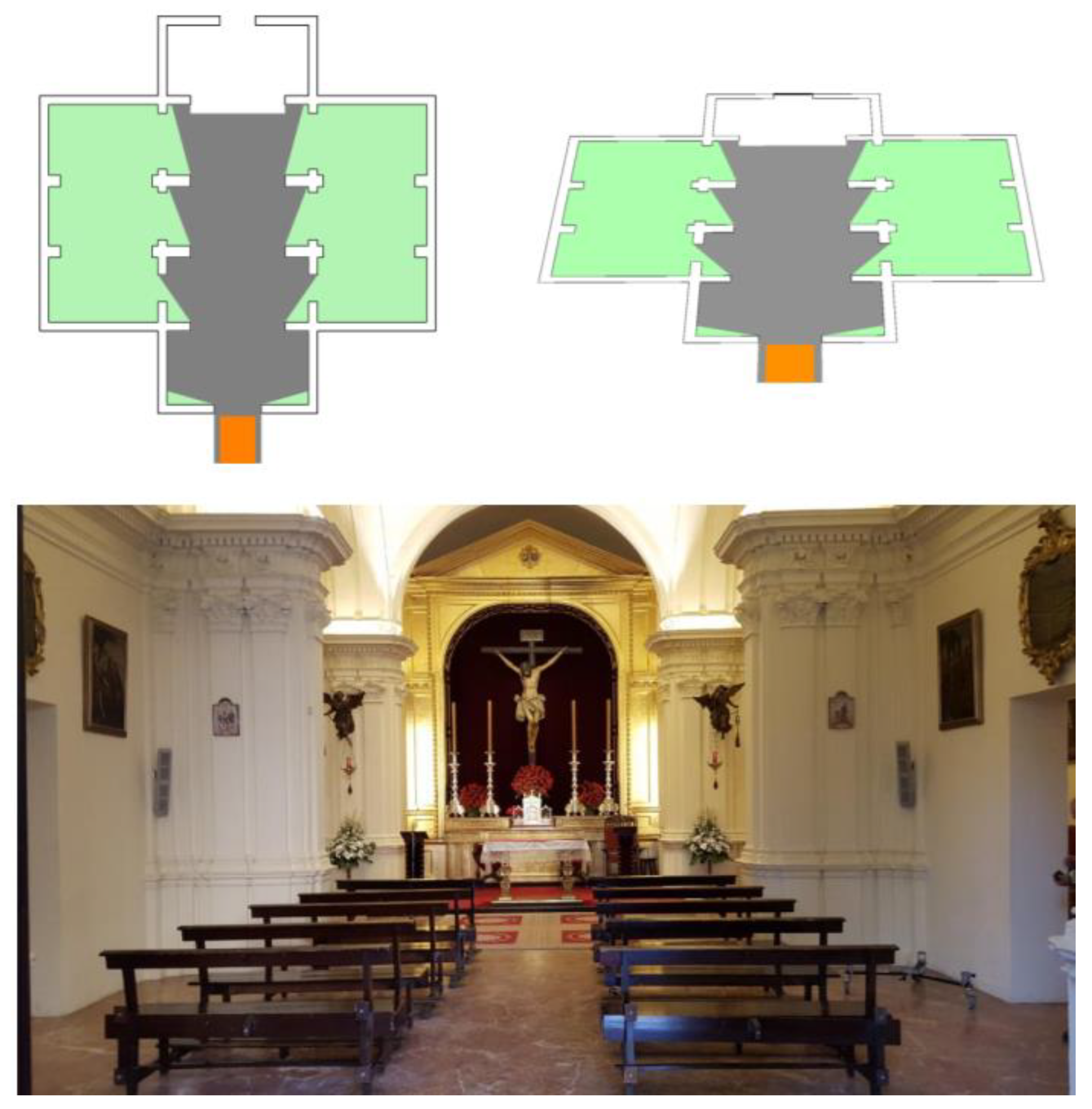
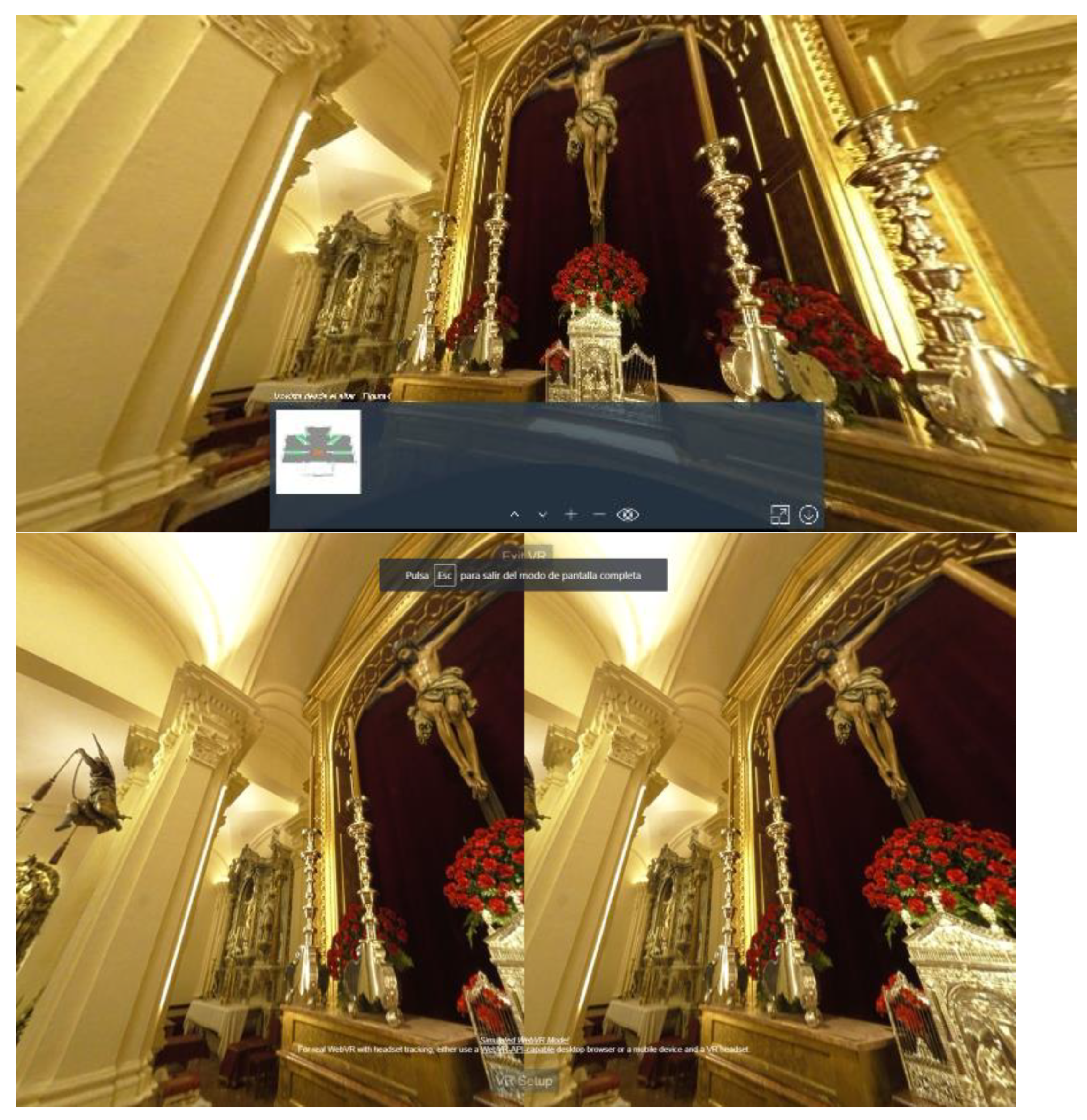
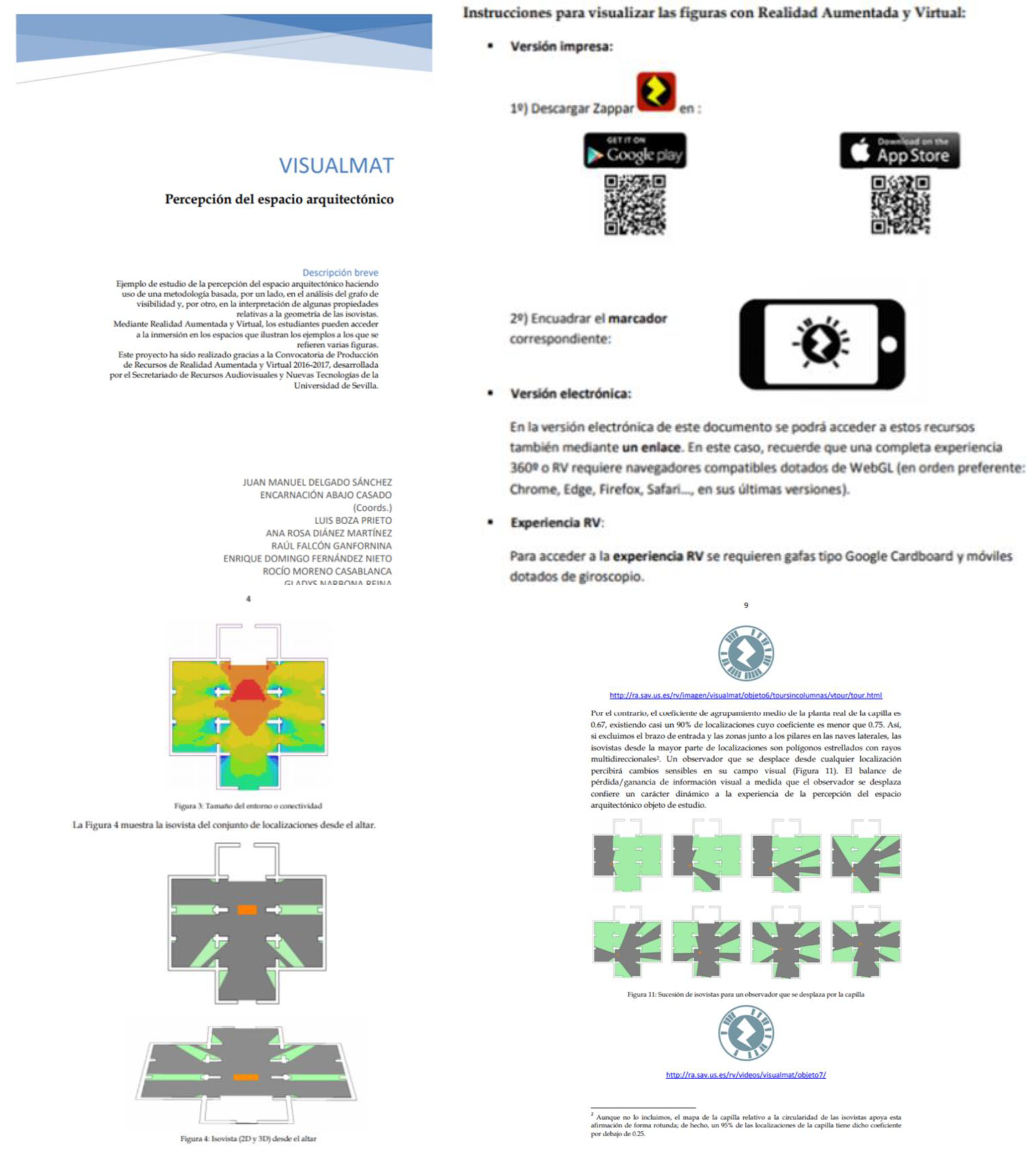
| Criterion | AR | VR | MR | IoT |
|---|---|---|---|---|
| User’s interaction with natural reality | High The real world is an environment in which interaction occurs from the digital information that is added therein. | Low Users isolate themselves from reality using a device to become immersed in a sensorial universe. | Medium The real world serves as a stage which projects the Virtual Reality in which the user is immersed by means of a device. | Low The user is a consumer of the information or performance of by things. |
| Level of immersion in a digital experience | Medium It depends on the digital density which is added to reality. | High It implies a full immersion in a completely digitized parallel reality | High The real world is replaced by a sensorial experience immersed in a virtual world. | Low The user performs in a real environment, albeit having the chance to connect with the objects in the cloud. |
| Emblematic device | Apps in AR-equipped Smartphones | Sensorial headphones | Lenses which project digital information on a real environment | Refrigerator able to provide information about the expiry date of food or to suggest recipes |
| Representative enterprise in technology development | Microsoft | Cisco | ||
| Development stage | Right in the middle of an expansive exploration period | In a readjustment period, after the initial bubble | Right in the middle of an experimental revolution | Immediate commercial boom |
| Technical Mastery Area | Gender | Mean | S.D. |
|---|---|---|---|
| Audiovisual resources | Male | 7.26 | 1.764 |
| Female | 6.90 | 2.095 | |
| Computer resources | Male | 7.48 | 1.855 |
| Female | 7.00 | 1.449 | |
| Internet | Male | 8.35 | 1.434 |
| Female | 7.62 | 1.717 |
| AUGMENTED REALITY | |
| SOFTWARE | WHAT IT IS USED FOR |
| Zappar | Application launcher |
| Sketahfab | 3D launcher |
| Android studio | Java development environment. Apk export for Android. |
| Autocard | Image design–3D retouching |
| Google sketah Up | 3D retouching |
| Adobe Photoshop | Creation of equirectangular images. Graphics |
| VIRTUAL REALITY | |
| Sketahfa | 3D launcher |
| Google Sketachfa | 3D launcher |
| Krpano | Making reality via a video image website |
| Google VR | Making reality via a video image website |
| MR | ||
|---|---|---|
| m | s.d. | |
| ||
| 1.1. The use of this system could enhance my learning in the classroom. (PU1) | 6.30 | 1.17 |
| 1.2. The use of this system during classes would make it easier for me to understand certain concepts. (PU2). | 6.65 | 0.65 |
| 1.3. I think the system is useful when one is learning. (PU3) | 6.38 | 1.16 |
| 1.4. The use of this system would improve my learning. | 6.40 | 1.14 |
| ||
| 2.1. In my opinion, the system is user-friendly. (PEU1) | 5.23 | 1.16 |
| 2.2. Learning to use and operate the system was not a problem for me. (PEU2) | 5.18 | 1.61 |
| 2.3. I found the explanations about how to use and operate the system clear and understandable. (PEU3) | 5.72 | 1.41 |
| ||
| 3.1. Utilizing the system was fun for me (PE1) | 6.82 | 0.39 |
| 3.2. I enjoyed myself using the system (PE2) | 6.58 | 0.81 |
| 3.3. In my view, the system allows you to learn while playing. (PE3) | 6.63 | 0.70 |
| ||
| 4.1. Using the system makes learning become more interesting. (AU1) | 6.62 | 0.55 |
| 4.2. In my opinion, using the system in the classroom is a good idea. (AU2) | 6.31 | 0.89 |
| ||
| 5.1. I would like to use these systems in the future if I had the chance. (IU1) | 6.65 | 0.71 |
| 5.2. I would like to use the system to learn both about the topics that were presented to me and about others (IU3). | 6.63 | 0.62 |
| Perceived usefulness (PU) | 6.43 | 1.03 |
| Perceived ease of use (PEU) | 5.28 | 1.39 |
| Perceived enjoyment (PE) | 6.68 | 0.63 |
| Attitude towards use (AU) | 6.47 | 0.72 |
| Intention to use (IU) | 6.64 | 0.72 |
| TAM GLOBAL VALUES | 6.30 | 0.89 |
| MR | ||
|---|---|---|
| m | s.d. | |
| 1. Technical and aesthetic aspects | ||
| 1.1. The operation of the resource that we have presented to you is: | 5.20 | 0.80 |
| 1.2. On the whole, you consider the aesthetics of the resource produced: | 5.08 | 1.02 |
| 1.3. In general, you would describe the technical functioning of the resource as: | 5.14 | 0.88 |
| 1.4. Broadly speaking, how would you assess the presentation of information on the screen? | 5.29 | 0.95 |
| 2. Ease of use | ||
| 2.1. How would you describe the user-friendliness and handling of the resource that we have presented to you? | 5.03 | 0.94 |
| 2.2. How would you describe the extent to which it is easy to understand the technical functioning of the resource that we have presented to you? | 5.32 | 0.91 |
| 2.3. How would you assess the overall design of the AR-resource produced? | 5.06 | 1.05 |
| 2.4. How would you assess the overall design of the resource that we have presented to you? | 4.71 | 1.37 |
| 2.5. How would you assess the flexibility in the utilization of the material that we have presented to you? | 5.19 | 1.06 |
| 2.7. Using the resource produced was fun for you: | 5.96 | 0.51 |
| TECHNICAL ASPECTS | 5.18 | 0.91 |
| EASE OF USE | 5.21 | 0.97 |
| TOOL TOTAL | 5.20 | 0.94 |
| Technical Mastery Area | Levene’s Test Sig. | T | Sig. | |
|---|---|---|---|---|
| Audiovisual resources | 1.458 | 234 | 612 | 544 |
| Computer resources | 1.536 | 222 | 946 | 349 |
| Internet resources | 105 | 748 | 1.533 | 133 |
| Dimension | T | Sig. |
|---|---|---|
| Perceived usefulness | 1.428 | 1605 |
| Perceived ease of use | 0.792 | 4820 |
| Perceived enjoyment | 0.899 | 3737 |
| Perceived Mastery | Perceived Ease of Use | Perceived Usefulness | Attitude Towards Use | |
|---|---|---|---|---|
| Audiovisual mastery | 217 | 019 | 427 ** | |
| Computer mastery | 106 | 006 | 407 ** | |
| Internet mastery | 108 | 015 | 472 ** | |
| Quality | 501 ** | 463 ** | 499 ** | |
| Perceived enjoyment | 609 ** | 732 ** | 798 ** | |
| Perceived ease of use | 569 ** | 563 ** | ||
| Perceived usefulness | 721 ** | |||
| Intention to use it | 789 ** | 673 ** | 792 ** |
| COMPUTER R. | INTERNET R. | |
|---|---|---|
| A/V RESOURCES | 639 ** | 456 ** |
| COMPUTER RESOURCES | 574 ** |
Publisher’s Note: MDPI stays neutral with regard to jurisdictional claims in published maps and institutional affiliations. |
© 2021 by the authors. Licensee MDPI, Basel, Switzerland. This article is an open access article distributed under the terms and conditions of the Creative Commons Attribution (CC BY) license (https://creativecommons.org/licenses/by/4.0/).
Share and Cite
Cabero-Almenara, J.; Barroso-Osuna, J.; Martinez-Roig, R. Mixed, Augmented and Virtual, Reality Applied to the Teaching of Mathematics for Architects. Appl. Sci. 2021, 11, 7125. https://doi.org/10.3390/app11157125
Cabero-Almenara J, Barroso-Osuna J, Martinez-Roig R. Mixed, Augmented and Virtual, Reality Applied to the Teaching of Mathematics for Architects. Applied Sciences. 2021; 11(15):7125. https://doi.org/10.3390/app11157125
Chicago/Turabian StyleCabero-Almenara, Julio, Julio Barroso-Osuna, and Rosabel Martinez-Roig. 2021. "Mixed, Augmented and Virtual, Reality Applied to the Teaching of Mathematics for Architects" Applied Sciences 11, no. 15: 7125. https://doi.org/10.3390/app11157125
APA StyleCabero-Almenara, J., Barroso-Osuna, J., & Martinez-Roig, R. (2021). Mixed, Augmented and Virtual, Reality Applied to the Teaching of Mathematics for Architects. Applied Sciences, 11(15), 7125. https://doi.org/10.3390/app11157125








